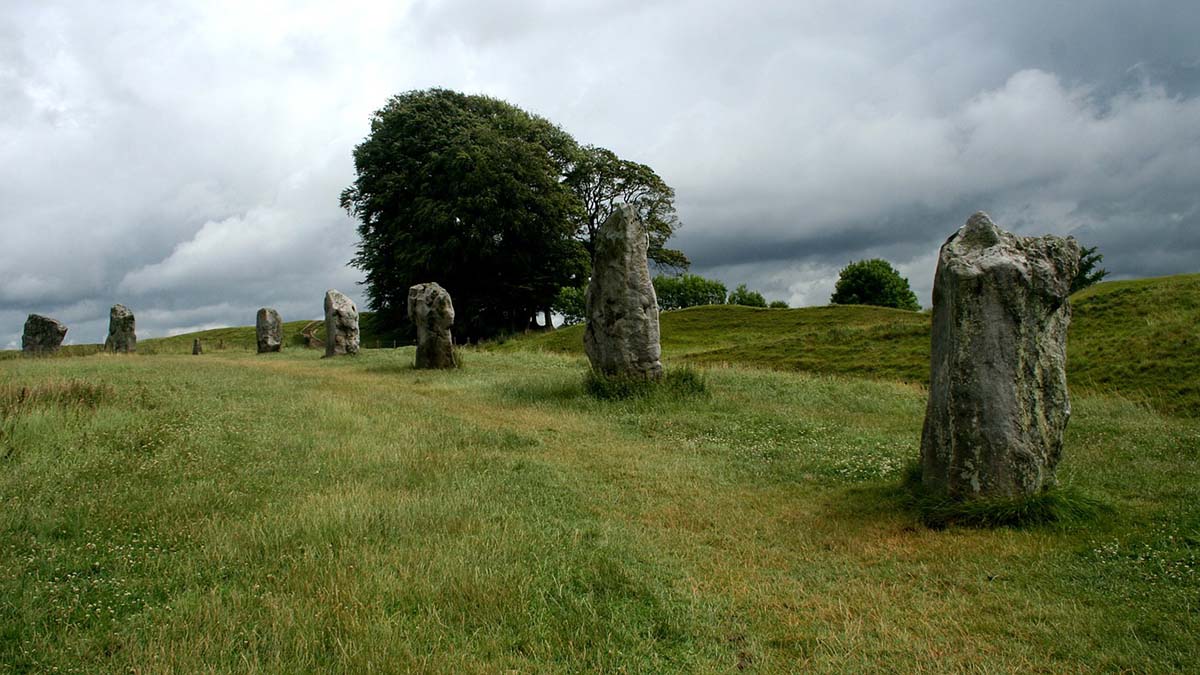
Wiltshire, England
by Keith Kellett
Stonehenge
Since I live nearby, and have a pass which allows me free entry, I can get to Stonehenge any time. But, when I first arrived in the area, I made a very special visit. I went to the Stones to be lectured about them by none other than John Aubrey, the English antiquarian … or rather a re-enactor playing his part.
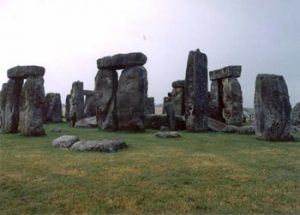 I’ve found out since that Aubrey has put around more misinformation about the Stones than probably anybody else has. Notably, he connected them inextricably with the Druids, which the experts doubt, although there are plenty of modern Druids at the Solstice celebrations, held on the longest and shortest days of the year. One story has it that King Charles II sent him to Wiltshire to investigate them not because of any expertise he may have had, but simply to get the drinking, gambling womanizer out of town for a while.
I’ve found out since that Aubrey has put around more misinformation about the Stones than probably anybody else has. Notably, he connected them inextricably with the Druids, which the experts doubt, although there are plenty of modern Druids at the Solstice celebrations, held on the longest and shortest days of the year. One story has it that King Charles II sent him to Wiltshire to investigate them not because of any expertise he may have had, but simply to get the drinking, gambling womanizer out of town for a while.
The triliths, horizontal stones, balanced on two upright ones, are unique to Stonehenge. Some of the stones in the older circle, called ‘bluestones’, were brought from as far away as Wales. Other, later circles were built from the rough sandstone called sarsen, the nearest deposit of which is about thirty miles away, on Lockeridge Down. To transport the huge stones that distance must have required an organized society, with an influential leadership. Or, as some people still believe, a hand from Merlin the Magician or some passing extra-terrestrials.
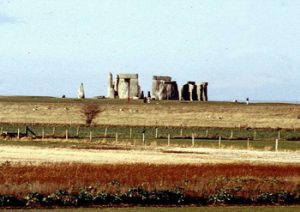 Stonehenge stands near a busy road junction. There’s a rather brutal visitor centre and car park and an ugly security fence surrounds the whole site. Hardly what a World Heritage site deserves. Another factor is that the nearby A303 road from London to Exeter becomes, for the first time since leaving the motorway, a single carriageway, leading to intolerable congestion at busy times.
Stonehenge stands near a busy road junction. There’s a rather brutal visitor centre and car park and an ugly security fence surrounds the whole site. Hardly what a World Heritage site deserves. Another factor is that the nearby A303 road from London to Exeter becomes, for the first time since leaving the motorway, a single carriageway, leading to intolerable congestion at busy times.
A lot of people express disappointment, maybe expecting the site to be on a remote hilltop somewhere. But, some people say there is still a sort of mystery about the place, even though the actual stones themselves are fenced off. Maybe it’s something to do with the fact that we only know approximately when it was built; how and by whom are informed theories, and why is anyone’s guess. It’s often said the known facts about Stonehenge can be typed on a single sheet of paper, and anything else is myth, theory and conjecture!
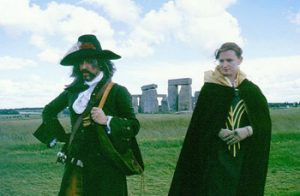 Although Stonehenge is more famous, there’s another, much bigger circle, or rather, complex of circles, thirty miles north, at Avebury, built about 500 years before Stonehenge. Work started here around 2900 BCE, while Stonehenge was not started till about 2400 BCE. But, some work was always going on, lasting, in both cases, more than a thousand years.
Although Stonehenge is more famous, there’s another, much bigger circle, or rather, complex of circles, thirty miles north, at Avebury, built about 500 years before Stonehenge. Work started here around 2900 BCE, while Stonehenge was not started till about 2400 BCE. But, some work was always going on, lasting, in both cases, more than a thousand years.
When John Aubrey came upon the circle at Avebury, he declared it far superior to Stonehenge, and said it was like ‘comparing a cathedral to a parish church’. While Aubrey did do some valuable work, he had an unfortunate habit of presenting his sometimes unsubstantiated theories about the stones as facts; a habit which confused people for generations. Modern scientists, though, make it clear that their theories are just that. ‘I think ‘may’, ‘possibly’ and ‘probably’ are the words we use most often of all’ I was once told.

 Avebury
Avebury
Much larger than Stonehenge, Avebury does not have any triliths or Welsh bluestones. Rather, it’s built entirely of sarsens. There’s a thriving village within the outer circle. The Salisbury to Swindon bus runs right through it, and is a convenient and cheap way of getting to it from either town.
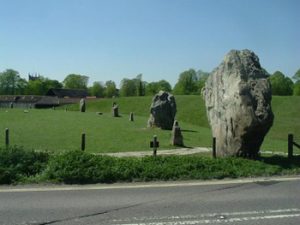 Like Stonehenge, there’s an avenue; that is, two lines of standing stones marking the edges of the approach to the circle. The one at Stonehenge consists of just two shallow furrows, which an untrained person would not recognize unless it was pointed out. In the 1920s, marmalade magnate and keen amateur archaeologist Alexander Keiller found the circles in a ruinous state. He located all of the missing stones he could find, transported them back to Avebury, and re-located them in their original positions. And, if a stone could not be found, a concrete obelisk was erected where it should have stood.
Like Stonehenge, there’s an avenue; that is, two lines of standing stones marking the edges of the approach to the circle. The one at Stonehenge consists of just two shallow furrows, which an untrained person would not recognize unless it was pointed out. In the 1920s, marmalade magnate and keen amateur archaeologist Alexander Keiller found the circles in a ruinous state. He located all of the missing stones he could find, transported them back to Avebury, and re-located them in their original positions. And, if a stone could not be found, a concrete obelisk was erected where it should have stood.
One thing that could not be taken away, though, was the massive henge surrounding the complex. It is always a source of wonder that this was dug out using only primitive tools. A modern civil engineer estimated that such an undertaking would take one man three years today, using a mechanical digger.
Nowadays, the ditch is covered in grass, but the original idea was just to have a circle of bare earth. In most of Wiltshire, this is a brilliant white chalk soil. It must have been a dramatic sight!
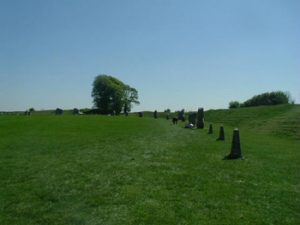 So enthusiastic was Keiller that he actually bought the land on which Avebury stood, as well as Avebury Manor, part of which is now the Alexander Keiller Museum. Many artifacts he found on his digs are displayed here: arrowheads, coins, pottery and skeletons of animals, and even humans! Also on display are objects from almost all points on the time-line, for the village was here from the earliest times, and many people would have grazed their sheep and cattle in the fields containing the stones. They would, no doubt, have inadvertently dropped coins, knives and the like.
So enthusiastic was Keiller that he actually bought the land on which Avebury stood, as well as Avebury Manor, part of which is now the Alexander Keiller Museum. Many artifacts he found on his digs are displayed here: arrowheads, coins, pottery and skeletons of animals, and even humans! Also on display are objects from almost all points on the time-line, for the village was here from the earliest times, and many people would have grazed their sheep and cattle in the fields containing the stones. They would, no doubt, have inadvertently dropped coins, knives and the like.
If you visit the sites, you will be immediately aware of a modern major difference between Avebury and Stonehenge. At Avebury, admission is free of charge, although you do have to pay to use the car park or enter the museum. But, you can wander around the stones as you will, even experiment with dowsing rods and the like, to see if there is any ‘power’ emanating from them. At Stonehenge, unless you make a special arrangement, you must admire them from a distance.
More Information:
John Aubrey (March 12, 1626–June 7, 1697) was an English antiquary and writer, best known as the author of the collection of short biographical pieces usually referred to as ‘Brief Lives’ and as the discoverer of the Aubrey holes in Stonehenge.”How these curiosities would be quite forgott, did not such idle fellowes as I am putt them down...”
– More about Alexander Keiller in Wikipedia
– Megalithic Portal: The Alexander Keiller Museum
– English Heritage: Stonehenge
– English Heritage: Avebury
– Details about public transport to these sites can be found at: http://www.wdbus.co.uk
– This is Wiltshire: Avebury
– About Britain: Things to do in Wiltshire
Stonehenge and Avebury Tours Now Available:
Stonehenge and Avebury Day Tour from London
Salisbury, Stonehenge, and Avebury in One Day from Salisbury
Stonehenge, Avebury, and West Kennet Long Barrow in One Day from Salisbury
Stonehenge, Salisbury Cathedral and Bath Including Pub Lunch
Stonehenge Special Access Evening Tour from London
About the author:
Having written as a hobby for many years while serving in the Royal Air Force, Keith Kellett saw no reason to discontinue his hobby when he retired. With time on his hands, he produced more work, and found, to his surprise, it ‘grew and grew’ and was good enough to finance his other hobbies; traveling, photography and computers. He is trying hard to prevent it from becoming a full-time job! He has published in many UK and overseas print magazines, and on the Web. He is presently trying to get his head around blogging, podcasting and video.
Contact: keith-kellett@tinyworld.co.uk
Photo credits:
First Avebury stone circle photo by Martin Krotil from Pixabay
All other photos are by Keith Kellett.



